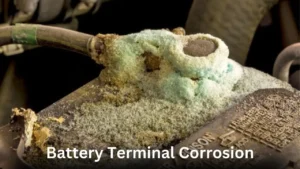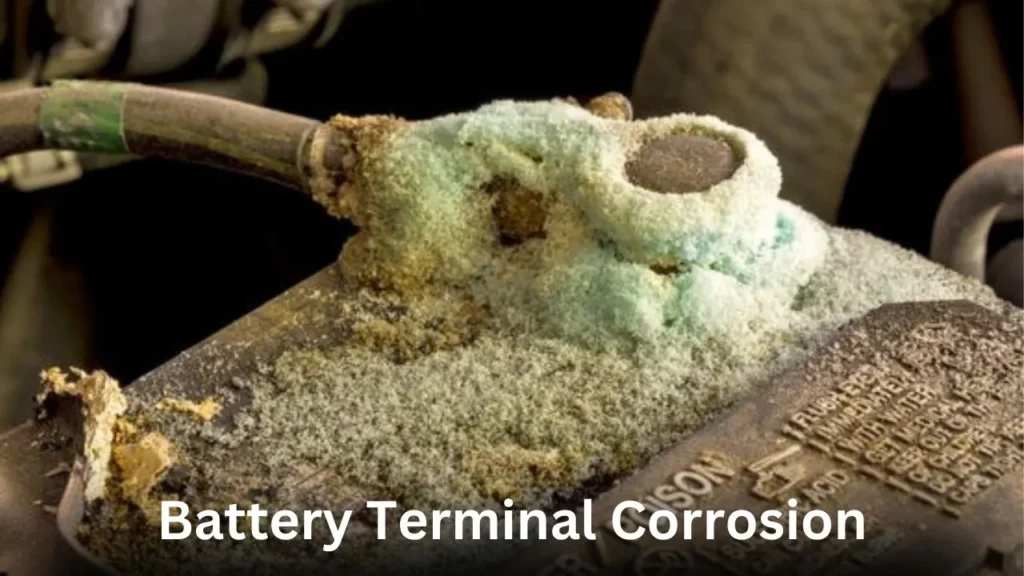
What causes battery terminal corrosion? It’s a question that leaves numerous scratching their heads as they blink into the complicate depths of their auto’s machine bay. In this post, we embark on a trip to clarify battery terminal corrosion, slipping light on its origins, its troubles, and most importantly, how to baffle its sharp rage. So buckle up as we navigate through the complications of this silent graffitist, empowering you with the knowledge to keep your battery and your auto — running easily.
What is battery terminal corrosion?
Battery terminal corrosion refers to the gradational declination or buildup of sharp material around the essence outstations and connectors of a battery. This corrosion generally occurs due to chemical responses between the essence outstations, electrolyte result (similar to sulfuric acid in (Lead-Acid Batteries), and environmental factors like humidity and pollutants. As the corrosion builds up, it can hamper the inflow of electricity between the battery outstations and connected factors, leading to poor electrical conductivity, voltage drops, and implicit battery failure. In appearance, battery terminal corrosion frequently manifests as a white, fine substance on the outstations or a blue-greenish crust on the connectors.
What causes battery terminal corrosion?
Then is an expanded list of causes of battery terminal corrosion:
- Electrolyte Leakage: The acidic nature of the electrolyte result in batteries, similar to sulfuric acid in lead-acid batteries, can lead to corrosion. Leakage of electrolyte due to battery damage or wear accelerates this process.
- Environmental Factors: Exposure to humidity, high temperatures, and pollutants like dirt and debris creates favorable conditions for corrosion. Humidity facilitates the chemical responses that beget erosion, while pollutants can complicate the sharp process.
- Galvanic erosion: When different essence come into contact with each other in the presence of an electrolyte, galvanic erosion can do. In a battery system, where different essence are used in the outstations and connectors, this miracle can accelerate erosion.
- Electrical Issues: Fleecing or discounting a battery can lead to the product of redundant hydrogen gas, which can contribute to erosion. Also, poor electrical connections, similar as loose outstations or inadequate contact area, can complicate corrosion.
- Age and Wear: As batteries age, the accoutrements within them break down and release chemicals and feasts that can contribute to corrosion over time.
- Overfilling with Water: Adding too important water to a battery can beget electrolyte overflow, leading to erosion of the outstations.
- Battery Damage: Physical damage to the battery covering or outstations can expose the internal factors to humidity and pollutants, adding the threat of corrosion.
Do battery corrosion mean I need a new battery?
Battery Corrosion doesn’t always mean you need a new battery. Minor corrosion can frequently be resolved through cleaning and conservation. Still, severe corrosion, damage to outstations or cables, or other signs like poor performance or visible battery damage may indicate the need for a relief. Signs that a battery may need relief include
- Age: Lead-Acid Batteries generally last about 3 to 5 times, depending on operation and conservation. Poor Performance If you are passing starting problems, dim lights, or other electrical issues despite drawing the outstations.
- Visible Damage: Cracked covering, leakage, or corrosion on the battery itself.
- Failed Load: Test A professional load test can determine the battery’s capability to hold a charge and deliver power. However, relief may be necessary, If it fails.
Is battery corrosion dangerous?
Yes, battery corrosion can be dangerous for several reasons:
- Electrical Malfunctions: corrosion buildup on battery outstations can hamper the inflow of electricity between the battery and connected factors. This can lead to electrical malfunctions in the vehicle, affecting critical systems similar as starting, lighting, and machine performance.
- Battery Failure: Severe corrosion can damage the outstations and connectors, compromising the battery’s capability to hold a charge and deliver power. This can affect in battery failure, leaving the vehicle unfit to start or operate duly.
- Safety: Risks sharp substances formed during battery corrosion, similar to sulfuric acid, can be dangerous if they come into contact with skin, eyes, or apparel. Ingestion of these substances can also pose serious health pitfalls.
- Fire Hazard: In extreme cases, inordinate corrosion or electrical arcing due to poor connections can produce sparks, adding the threat of a fire or explosion under the hood of the vehicle.
- Environmental Impact: Corrosion residue and blurted electrolyte can pollute the girding terrain if not duly gutted and disposed of, posing pitfalls to soil, water sources, and wildlife.
Overall, while battery corrosion may feel like a minor issue, it has the implicit to beget significant safety hazards and vehicle malfunctions if left unbounded. Regular examination, conservation, and prompt cleaning of eroded outstations are essential to help these pitfalls and insure the safe operation of the vehicle.
Can corrosion cause battery to die?
Yes, corrosion can indeed beget a battery to die precociously. Then is how:
- Poor Electrical: Conductivity corrosion buildup on battery outstations creates a hedge between the battery and the connected factors, hindering the inflow of electricity. This poor electrical conductivity can help the battery from effectively delivering power to the vehicle’s electrical systems, leading to starting problems, dim lights, and other electrical malfunctions.
- Voltage Drops: As corrosion increases on the outstations and connectors, it can produce resistance in the electrical circuit. This resistance causes voltage drops, reducing the quantum of power available to the vehicle’s systems. In severe cases, voltage drops can come significant enough to help the battery from supplying sufficient power, performing in the vehicle’s incapability to start or operate duly.
- Internal Damage: Corrosion can also damage the internal factors of the battery, similar as the lead plates and partitions. This damage can reduce the battery’s capacity to hold a charge and deliver power, eventually leading to dropped performance and unseasonable failure.
- Short Circuits: Inordinate corrosion can beget electrical films between the battery outstations or between the outstations and girding essence factors. These short circuits can drain the battery’s charge fleetly, causing it to die suddenly.
Key Points
| Key Points | Description |
| Battery Terminal Corrosion | Gradual degradation or buildup of corrosive material around battery terminals and connectors. |
| Causes of Corrosion | – Electrolyte Leakage – Environmental Factors – Galvanic Corrosion – Electrical Issues – Age and Wear – Overfilling with Water – Battery Damage |
| Need for Battery Replacement | Signs include age, poor performance, visible damage, and failed load test. |
| Dangers of Corrosion | Electrical malfunctions, battery failure, safety risks, fire hazards, environmental impact. |
| Corrosion’s Effect on Battery Life | Premature battery failure due to poor electrical conductivity, voltage drops, internal damage, and short circuits. |
| Preventive Measures | Regular inspection, cleaning with baking soda, sealing and protection, proper installation, avoiding overfilling, environmental protection, corrosion-resistant terminals, regular maintenance. |
How to stop battery terminal corrosion:
To help battery terminal corrosion, follow these ways:
Regular examination
- Routinely check your battery outstations for signs of corrosion. Look for white, fine residue or blue-greenish crust on the outstations and connectors.
Cleaning with Baking Soda
- Mix incinerating soda pop with water to produce a cleaning result.
- Use a line encounter or terminal cleaning tool to drop the corrosion from the outstations and connectors.
- Baking soda pop is effective at negativing acidic corrosion without causing damage to the outstations.
Rinse and Dry
- After drawing, wash the outstations with clean water to remove any residue.
- Sot them completely with a clean cloth or compressed air to help humidity buildup.
Sealing and Protection
- Apply a thin subcaste of petroleum jelly or terminal protectant spray to the outstations and connectors after drawing. This helps produce a hedge against humidity and pollutants, reducing the threat of erosion.
Proper Installation
- Ensure that the battery outstations are securely tensed to the battery posts. Loose outstations can produce gaps where humidity and pollutants can enter, accelerating corrosion.
Avoid Overfilling
- When adding water to a lead-acid battery, be careful not to overfill it. Redundant water can overflow and beget electrolyte leakage, leading to corrosion of the outstations.
Environmental Protection
- Park your vehicle in a sheltered area to minimize exposure to humidity and extreme temperatures.
- Still, consider using a battery sequestration tackle or cover to cover the battery from the rudiments, If parking outside is necessary.
Use corrosion-Resistant Outstations
- Consider replacing standard battery outstations with corrosion-resistant druthers, similar to lead-free or coated outstations, to minimize the threat of erosion.
Regular conservation
- Incorporate battery conservation into your vehicle’s regular servicing schedule.
- This includes checking the battery’s overall health, icing proper charging, and addressing any issues instantly to help corrosion from worsening.
By following these preventative measures, you can effectively stop battery terminal erosion and protract the life of your vehicle’s battery. Regular conservation and visionary care are crucial to icing dependable performance and precluding unanticipated failures.
Conclusion
Understanding What causes battery terminal corrosion is pivotal for maintaining the health and life of your vehicle’s battery. In this post, we have explored the origins of battery terminal erosion, its implicit troubles, and how to help it from wreaking annihilation on your vehicle’s electrical system. By relating the causes of erosion and enforcing visionary measures, you can cover your battery from unseasonable failure and insure the dependable operation of your vehicle.







